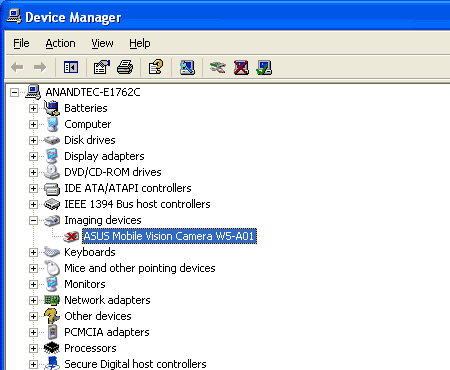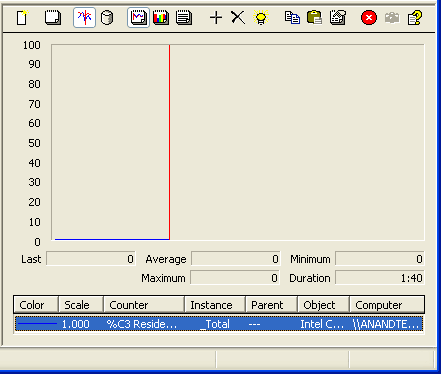Intel Core Duo USB Issue: A Mischaracterized Bug
by Anand Lal Shimpi on February 13, 2006 1:40 PM EST- Posted in
- Laptops
Problem #2 - Disabling a USB device doesn't work
If we now know that this problem should affect both Napa (Core Duo) and Sonoma (Pentium M) platforms, why is it that the results that we've seen to date don't support that theory? While we can only comment on tests that we've run ourselves, we did run into some issues with the ASUS W5F/W5A notebooks, which are quickly becoming popular Napa/Sonoma test platforms.
The reason that the two ASUS notebooks are nice to use is because they are virtually identical systems, one simply uses a Sonoma motherboard with a Pentium M CPU while the other uses a Napa board with a Core Duo CPU. In the end, it provides an excellent level playing field for comparing Core Duo to its predecessor.
With a USB 2.0 device (an external TV tuner) connected, but no driver installed, the battery life on our T60 dropped from 286 minutes down to 242, a reduction of 15.3%. Disabling the device had no effect either, as we recorded a battery life of 235 minutes. These findings are particularly important because both ASUS notebooks, the Sonoma and the Napa, feature an integrated USB 2.0 camera. Even without the drivers loaded, short of ripping the camera out of the system, these two notebooks are terrible reference points for the USB power draw issue as both of them exhibit the issue without even plugging in any external devices!
To confirm, we looked at C3 time once more on both platforms:
To further confirm, we applied the workaround documented in the Microsoft KB article. With no external devices connected to either system, their battery life jumped by approximately another hour:
While this means that our battery life tests from our Core Duo notebook article are significantly lower than they should be (we'll be providing a follow-up to that article in the near future), it also means that neither ASUS notebook should be used in pinpointing the cause or effects of this USB problem.
Adding an external USB 2.0 device to either ASUS notebook does result in an additional drop in battery life, but the initial damage is done by the integrated camera that you can't unplug. To truly isolate this problem, we'll need two notebooks that don't have any integrated USB 2.0 devices, which is why we turned to the Lenovo Thinkpad T43 and T60.
If we now know that this problem should affect both Napa (Core Duo) and Sonoma (Pentium M) platforms, why is it that the results that we've seen to date don't support that theory? While we can only comment on tests that we've run ourselves, we did run into some issues with the ASUS W5F/W5A notebooks, which are quickly becoming popular Napa/Sonoma test platforms.
The reason that the two ASUS notebooks are nice to use is because they are virtually identical systems, one simply uses a Sonoma motherboard with a Pentium M CPU while the other uses a Napa board with a Core Duo CPU. In the end, it provides an excellent level playing field for comparing Core Duo to its predecessor.

| Lenovo T60 | Nothing Connected | USB 2.0 Device Connected, No Driver Installed | USB Device Disabled |
| Reader 2002SE Battery Life in Minutes | 286 | 242 | 235 |
With a USB 2.0 device (an external TV tuner) connected, but no driver installed, the battery life on our T60 dropped from 286 minutes down to 242, a reduction of 15.3%. Disabling the device had no effect either, as we recorded a battery life of 235 minutes. These findings are particularly important because both ASUS notebooks, the Sonoma and the Napa, feature an integrated USB 2.0 camera. Even without the drivers loaded, short of ripping the camera out of the system, these two notebooks are terrible reference points for the USB power draw issue as both of them exhibit the issue without even plugging in any external devices!
To confirm, we looked at C3 time once more on both platforms:

The ASUS notebooks never enter C3 or lower power states, even with no external devices connected
To further confirm, we applied the workaround documented in the Microsoft KB article. With no external devices connected to either system, their battery life jumped by approximately another hour:
| Reader 2002SE Battery Life in Minutes | Nothing Connected | Nothing Connected (MS Fix Applied) |
| ASUS W5F (Napa/Core Duo) | 219 | 264 |
| ASUS W5A (Sonoma/Pentium M) | 204 | 273 |
While this means that our battery life tests from our Core Duo notebook article are significantly lower than they should be (we'll be providing a follow-up to that article in the near future), it also means that neither ASUS notebook should be used in pinpointing the cause or effects of this USB problem.
Adding an external USB 2.0 device to either ASUS notebook does result in an additional drop in battery life, but the initial damage is done by the integrated camera that you can't unplug. To truly isolate this problem, we'll need two notebooks that don't have any integrated USB 2.0 devices, which is why we turned to the Lenovo Thinkpad T43 and T60.










61 Comments
View All Comments
Anand Lal Shimpi - Monday, February 13, 2006 - link
It's not a refusal to test, we're simply not sent any for review :) My next article will be a look at Core Duo vs. Turion performance on the desktop, but I'm still working on securing notebook review units. I would like to see if this issue does impact AMD systems as well, and to what degree.After the Core Duo vs. Turion piece, if we still haven't gotten a Turion notebook in house I'll just buy one for this comparison.
Take care,
Anand
havokprod - Monday, February 13, 2006 - link
Does this problem surface with SP1??DigitalFreak - Monday, February 13, 2006 - link
Microsoft has supposedly known about this since at least July 2005. WTF? Why hasn't this been fixed yet?scavio - Monday, February 13, 2006 - link
It must have been difficult to mention and actually link to Tom's, I'm glad to see professionalism still lives.Very nice job on the article, it looks as though you guys went the extra mile and actually did the work to try figure out what was going on. I read the Tom's article a couple of weeks ago and although they uncovered an important issue they seemed to think they could try to get to the bottom of it with phone calls rather than getting their hands dirty and taking the time to test things themselves.
hergieburbur - Tuesday, February 14, 2006 - link
While the technical aspects of this article are intriging, I think there is too much editorial opinion added on top of that.I think the main reason they post the link to Toms is to dispute the claim Tom's supposedly made that this was a Core Duo issue. That is not what the original article stated, though several times in this article there are thinly veiled allusions to that supposed claim.
I think that tech sites should spend a little more time focusing on themselves and the products they review, and a little less trying to show how they are better than the rest. That goes for all sites. You work speaks for itself.
Anand Lal Shimpi - Tuesday, February 14, 2006 - link
The reason for linking the THG article was to avoid taking credit for a discovery that I did not make. They were the first to stumble upon the issue and it was their article that inspired a deeper investigation, which eventually resulted in this article.The point of this article wasn't to show how we were somehow better, but to address the mischaracterization of the problem. The THG results show a tremendous penalty on their Core Duo notebook due to the issue but a relatively small penalty on their Sonoma platform; this article was designed to explain why that was and hopefully clear up the very common misconception that this is predominantly a Core Duo problem.
The problem is that lots of people linked to that first article, and a very large number of those links incorrectly referred to the problem as a Core Duo issue based on the results that were originally presented. In reality, this problem appears to be nothing more than a Microsoft issue that impacts both Core Duo and Pentium M systems (I'm trying to figure out if it impacts Turion systems as well) but it was grossly mischaracterized in its public acception. I don't really care whose fault that is (personally I believe it's the fault of those who linked to the original article without thoroughly reading it), but I do care that the right information gets out there, which is what this article was designed to do.
I learned long ago that the best you can do is to put your best foot forward and let the reader decide on their own how they feel about you. I'm not trying to shape anyone's view of another site through my work, I'm just trying to get the most accurate information out there.
Take care,
Anand
DigitalFreak - Monday, February 13, 2006 - link
That's why Tomshardware sucks and Anandtech doesn't. That and other things *cough*bias *cough*.Anand Lal Shimpi - Monday, February 13, 2006 - link
Be nice guys, if it weren't for the original THG article it would've taken much longer for this investigation to even happen. I just wanted to make sure that the bug was properly characertized and even more importantly, I want to actually see a fully functional fix from Microsoft that works even out of standby.Take care,
Anand
Zebo - Monday, February 13, 2006 - link
Careful back in the day TOMs revealed many of intels buggy hardware (i820, MTH, crashing dualcores ...)bupkus - Monday, February 13, 2006 - link
Look, I just read the intro and the conclusion, and I don't even own a laptop, but...[see subject], I do have an external hard drive and plans to get a laptop.